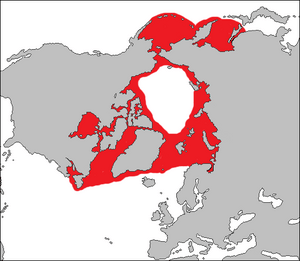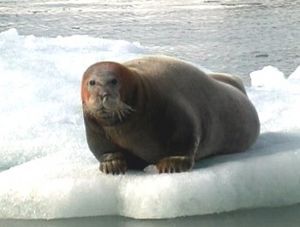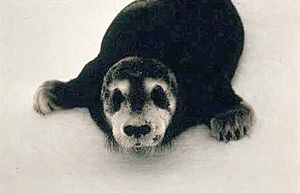Bearded seal facts for kids
Quick facts for kids Bearded Seal |
|
|---|---|
 |
|
| Conservation status | |
| Scientific classification | |
| Kingdom: | |
| Phylum: | |
| Class: | |
| Order: | |
| Family: | |
| Genus: |
Erignathus
Gill, 1866
|
| Species: |
E. barbatus
|
| Binomial name | |
| Erignathus barbatus Erxleben, 1777
|
|
 |
|
| Distribution of bearded seal | |
The bearded seal (Erignathus barbatus) is also known as the square flipper seal. It is a medium-sized seal that lives in and around the Arctic Ocean.
Scientists have found old fossils that show bearded seals once lived much farther south. During the Pleistocene Ice Age, they were found as far south as South Carolina.
About Bearded Seals
Bearded seals are a type of earless seal. They have special square-shaped front flippers. Their faces have very thick whiskers, like a beard. This is how they got their name!
Adult seals are usually brownish-grey. Their backs are often a bit darker. Sometimes, their faces and necks can look reddish-brown. Baby bearded seals, called pups, are born with greyish-brown fur. They have white patches on their backs and heads.
Bearded seals are unique because they have two pairs of teats. Most other seals only have one pair. This is a feature they share with monk seals.
These seals can grow to be about 2.1 to 2.7 meters (7 to 9 feet) long. They weigh between 200 and 430 kilograms (440 to 950 pounds). Both male and female seals are usually about the same size.
Bearded seals are an important food source for polar bears. They are also hunted by the Inuit people who live along the Arctic coast. These seals have a lot of body fat, usually 30–40% of their weight. This fat helps them stay warm in the cold Arctic waters.
Hunting and Diet
Bearded seals find their food on the ocean floor. They eat many different small creatures. This includes clams, squid, and various types of fish.
Their thick whiskers are very useful. They act like feelers, helping the seals find food hidden in the soft mud at the bottom of the ocean.
Adult bearded seals usually stay in shallow coastal areas. They prefer waters that are no deeper than 300 m (980 ft) (980 feet). However, young pups, up to one year old, will dive much deeper. They can go as deep as 450 m (1,480 ft) (1,480 feet) to find food.
Reproduction and Life Cycle
Bearded seals have their babies in the spring. In the Canadian Arctic, pups are born in May. Farther south, in Alaska, most pups arrive in late April.
Pups are born on small pieces of floating ice, called ice floes. These ice floes are usually in shallow water. A newborn pup weighs about 30–40 kilograms (66–88 pounds). They can enter the water just hours after they are born! They quickly become very good at diving.
Mothers take care of their pups for about 18 to 24 days. During this time, the pups grow very fast. They gain about 3.3 kilograms (7.3 pounds) each day. Pups drink a lot of milk, about eight liters (2 gallons) every day. By the time they stop drinking milk, they weigh around 100 kilograms (220 pounds).
Just before the pups are ready to be on their own, the adult seals start a new mating cycle. Female seals are ready to have babies again at the end of their nursing period. They stay close to their pups, ready to protect them if needed.
During the mating season, male seals make special "singing" sounds. These sounds might help them attract female seals. They might also use the sounds to show other males which areas are theirs. Male seals often return to the same areas each year.

See also
 In Spanish: Foca barbuda para niños
In Spanish: Foca barbuda para niños



